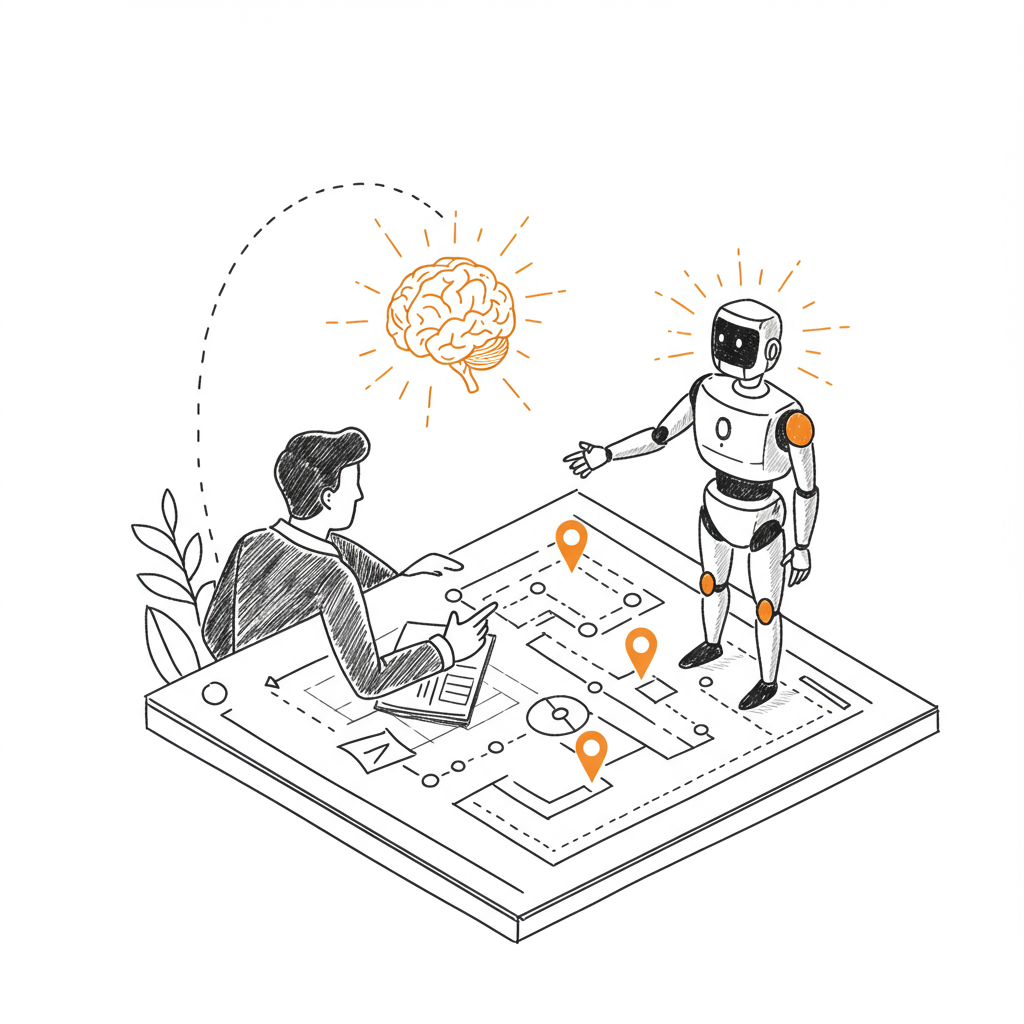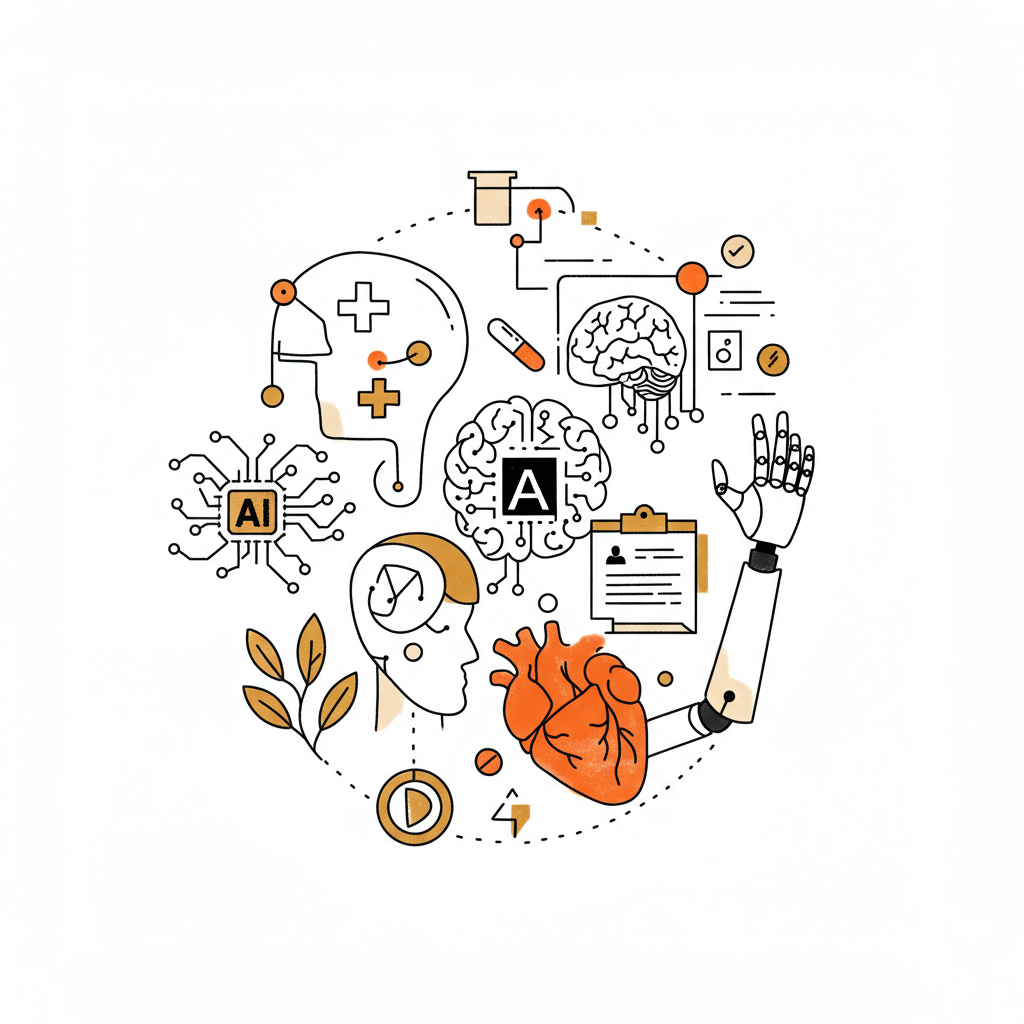Proof of Concept AI Consulting to Validate Your Vision
Discover how proof of concept AI consulting can de-risk your project, validate your ideas, and turn AI concepts into business success. Get started today!
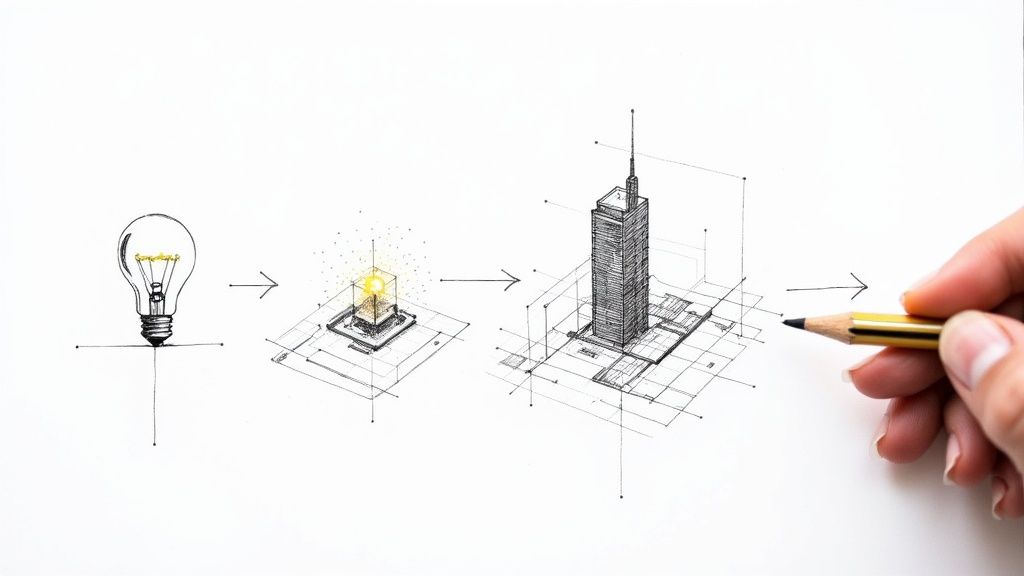
Staring at a big AI idea can feel like looking at an empty plot of land—full of potential, but also a whole lot of uncertainty. A proof of concept in AI consulting is the architect's blueprint for that plot. It’s a small, focused test to see if your idea is actually feasible and makes business sense before you start pouring in serious money and time.
From Big Idea to Business Blueprint
So many businesses have brilliant ideas for how AI could help them, but they get stuck before they even start. The fear of kicking off a massive, expensive project that might fall flat is real. This is exactly where a Proof of Concept (PoC) comes in, helping you turn a vague idea into something you can actually see and test, all with minimal risk.
Think of it this way: you wouldn't construct a skyscraper without first building a scale model and drawing up detailed plans. A PoC does the same job for your AI project. It’s not about building the entire, finished product. Instead, it’s about proving the core idea works, and doing it quickly and affordably.
This initial step, typically guided by experienced consultants, is designed to answer the one question every leader is asking: 'Will this AI thing actually solve our problem and be worth the investment?'
Why a PoC Is a Smart First Move

A PoC isn't just a tech demo; it's a strategic move. It takes the most important piece of your proposed AI system and tests whether it can hold up in a controlled setting. The whole point is to collect hard evidence to justify going any further.
Working with specialists through AI co creation makes sure this process is disciplined and focused on results. It’s all about taking the risk out of innovation. This process helps you:
Confirm technical viability: Can the AI model even do what you need it to do?
Gauge business impact: Will solving this problem actually make a difference to your bottom line or how you operate?
Spot roadblocks early: Discover problems with data, integration, or other hurdles before they become major disasters.
Get stakeholders on board: Showing people a working concept is infinitely more powerful than just talking about it in a presentation.
A well-run PoC is the best way to turn doubt into confidence. It stops the "what if" conversations and provides a clear "here's how" demonstration, giving you the data you need to make smart decisions.
At the end of the day, a PoC connects a promising idea to a solid business case. It's the critical starting point for any AI strategy consulting project, making sure you begin with a strong foundation. By proving the concept on a small scale, you build the evidence—and the excitement—needed for a full-scale rollout. This methodical approach ensures your big ideas actually make it off the whiteboard and become powerful blueprints for your business.
Why a PoC Is Your Best Insurance Against AI Failure

Jumping headfirst into a massive AI project without testing the waters first is a recipe for disaster. Think of it like trying to build a skyscraper without laying a foundation—it’s a high-stakes gamble that almost never pays off. This is precisely why a Proof of Concept (PoC) isn't just a "nice-to-have"; it's an essential first step for any company serious about making AI work.
A proof of concept in AI consulting is your best insurance policy against wasted time, money, and resources. It moves the conversation from abstract promises to concrete results. Instead of asking executives for a huge budget based on theory, a PoC gives you a working model and real data to show them, making it much easier to get the green light.
De-Risking Your AI Investment
At its core, a PoC is all about minimizing risk. It’s a hard truth, but a startling number of AI projects simply don't deliver the value they promise. This often happens because of unexpected technical problems or because the solution doesn't actually solve a real business need.
A PoC tackles these issues from the get-go. By starting with a small, focused project, you can:
Validate Technical Feasibility: Can the AI actually perform the task you need it to, using your specific data and within your existing systems? A PoC gives you the answer.
Uncover Hidden Roadblocks: It helps you spot problems early on—things like poor data quality, tricky integrations, or model limitations—when they are still cheap and easy to fix.
Refine the Project Scope: The initial findings allow you to build a much more realistic and accurate plan for the full-scale project.
Here's a thought: a "failed" PoC is actually one of your best possible outcomes. For a small investment of time and money, it proves that an idea won't work, potentially saving you from a multi-million dollar mistake down the road.
Building Momentum and Expertise
Beyond just managing risk, a PoC is a fantastic way to build knowledge and confidence within your own team. It acts as a controlled experiment, giving your people hands-on experience with how AI works in a practical, low-pressure setting.
This structured process, ideally guided by a solid AI strategy framework, makes sure your first foray into AI is a confident one. It connects the technical work directly to clear business objectives, turning what could be a risky venture into a smart, calculated investment. This is how you build the foundation for an AI solution that not only scales but also delivers real, measurable business value.
Your AI Proof of Concept Journey Step by Step
Kicking off a proof of concept for an AI project can feel like a huge undertaking, but thinking of it as a structured journey turns that uncertainty into a clear, actionable plan. A successful proof of concept in AI consulting isn't about guesswork; it follows a deliberate, multi-stage process designed to test an idea efficiently and deliver hard evidence of its value. Think of it less as building a full-scale product and more as a focused sprint to get a solid 'yes' or 'no' on whether the idea is even feasible.
This step-by-step approach, from defining the problem to validating the outcome, is what keeps the project from going off the rails. The visual below gives you a high-level look at how a typical PoC flows.
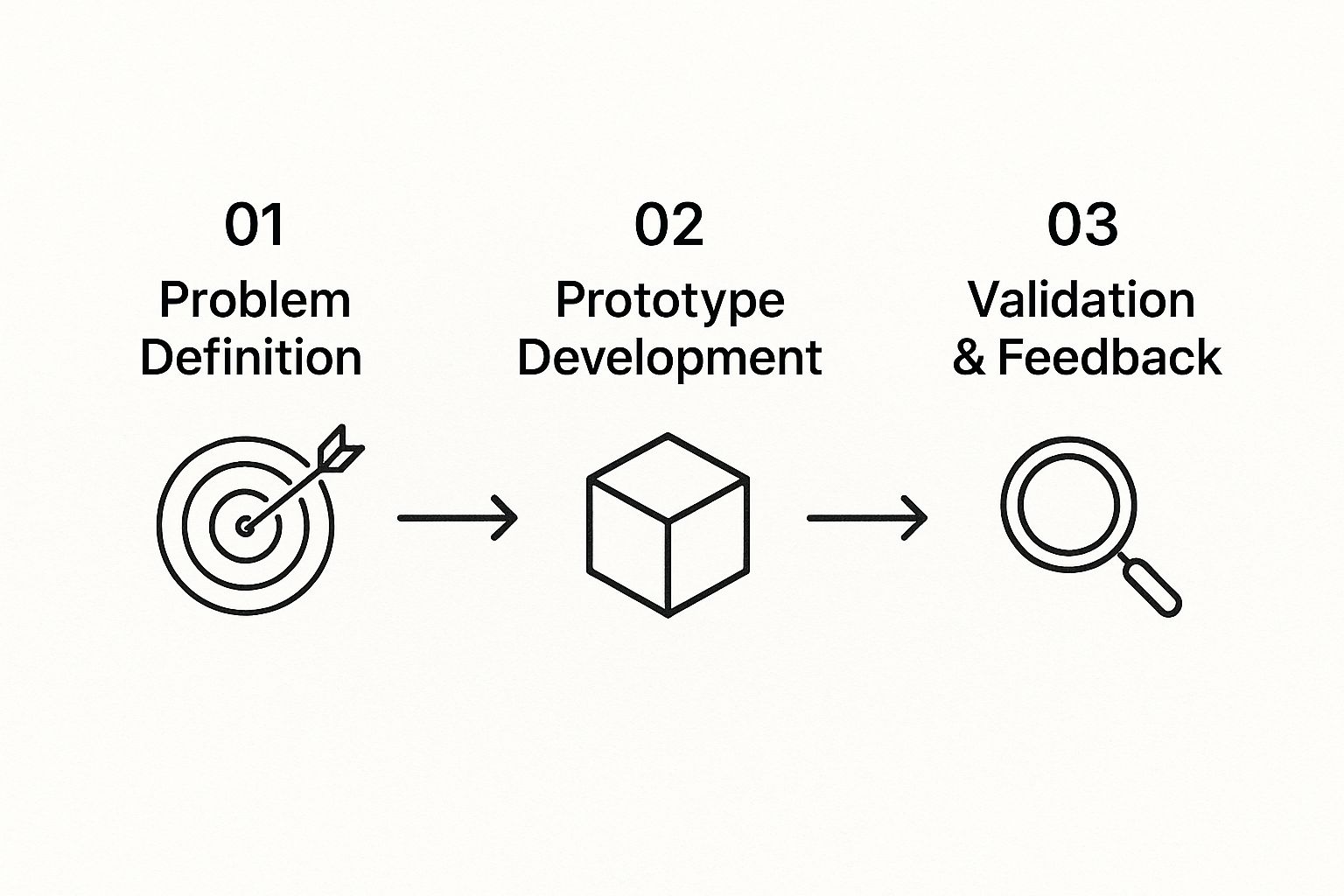
As you can see, a PoC is a logical progression. It starts with a well-defined problem, moves into building a testable model, and finishes with a rigorous evaluation. Each step builds directly on the one before it.
The Key Stages of an AI PoC
Let's break down the journey into its core phases. A well-managed PoC moves methodically from a broad idea to a validated concept, ensuring no time or resources are wasted.
Here’s a table outlining the typical phases, their goals, and the activities involved:
Phase | Objective | Key Activities |
|---|---|---|
1. Discovery & Strategy | Define a clear, measurable business problem and select a high-impact use case. | Brainstorming sessions, stakeholder interviews, prioritizing potential projects, setting specific success metrics (e.g., "reduce ticket resolution time by 20%"). |
2. Data Preparation | Gather, assess, and clean the necessary data to train the AI model. | Identifying data sources, data collection, cleaning and formatting data, handling missing values, ensuring data quality and relevance. |
3. Model Development & Testing | Build a lightweight prototype to test the core hypothesis. | Selecting appropriate algorithms, developing a minimum viable model, testing the prototype against the pre-defined success metrics. |
4. Analysis & Business Case | Evaluate the PoC's performance and present the findings to stakeholders. | Analyzing test results, documenting successes and failures, calculating potential ROI, and building a compelling business case for full-scale development. |
Each phase is crucial for de-risking the project and building the confidence needed to move forward.
Step 1: Define Success and Prioritize the Use Case
Honestly, this first step is the most critical. You need to get crystal clear on what you're trying to achieve. Vague goals like "improving efficiency" just won't cut it. A solid PoC starts with a sharp, measurable objective, something like "reduce customer service response times by 15%" or "increase lead qualification accuracy by 25%."
This is also the moment to get ruthless with prioritization. You might have a dozen exciting ideas for AI, but a PoC demands focus on a single, high-impact yet achievable use case. Your first project should be significant enough to matter to the business but simple enough to complete in just a few weeks. The real goal here is to score a quick win that builds momentum and shows stakeholders what's possible. Intensive sessions, like a dedicated AI strategy workshop, are fantastic for getting everyone aligned and zeroing in on that perfect starting point.
Step 2: Prepare Your Data
Data is the lifeblood of any AI model. Without high-quality, relevant data, even the most sophisticated algorithm is completely useless. This stage is all about identifying the right data sources, pulling that information together, and—most importantly—cleaning it up.
Don't be surprised if data preparation becomes the most time-consuming part of your PoC. It often involves tedious tasks like removing duplicates, fixing errors, and making sure everything is formatted consistently. A good consulting partner can be a lifesaver here, helping you assess your data readiness and figure out if you even have what you need to move forward.
Key Insight: The quality of your PoC's results is directly tied to the quality of your input data. "Garbage in, garbage out" isn't just a cliché; it's the unbreakable law of AI.
Step 3: Build and Test the Prototype Model
With a clear goal in your sights and clean data in hand, it's finally time to start building. An experienced AI consultant will pick the right algorithms and techniques to create a small-scale prototype. This isn't a polished, customer-facing system. It’s a lean, mean model built for one thing only: to prove the core concept works.
This prototype is then put to the test against the success metrics you defined back in step one. For instance, if your goal was to flag fraudulent transactions, the model's accuracy would be meticulously measured and analyzed. This is where the rubber meets the road.
Step 4: Analyze Results and Build the Business Case
The moment of truth arrives—the results are in. Did the model hit its targets? This final stage is all about digging into the analysis and communicating the findings clearly. The outcomes, both the wins and the losses, are compiled into a comprehensive report.
From a financial perspective, PoCs are designed to be a manageable first step. The cost for a straightforward AI PoC typically falls between $10,000 and $50,000. It's a relatively small investment to validate a potentially game-changing idea. This investment gives you the concrete data you need to build a rock-solid business case for the next phase, turning your successful experiment into a strategic initiative for the whole company.
How to Choose the Right AI Consulting Partner
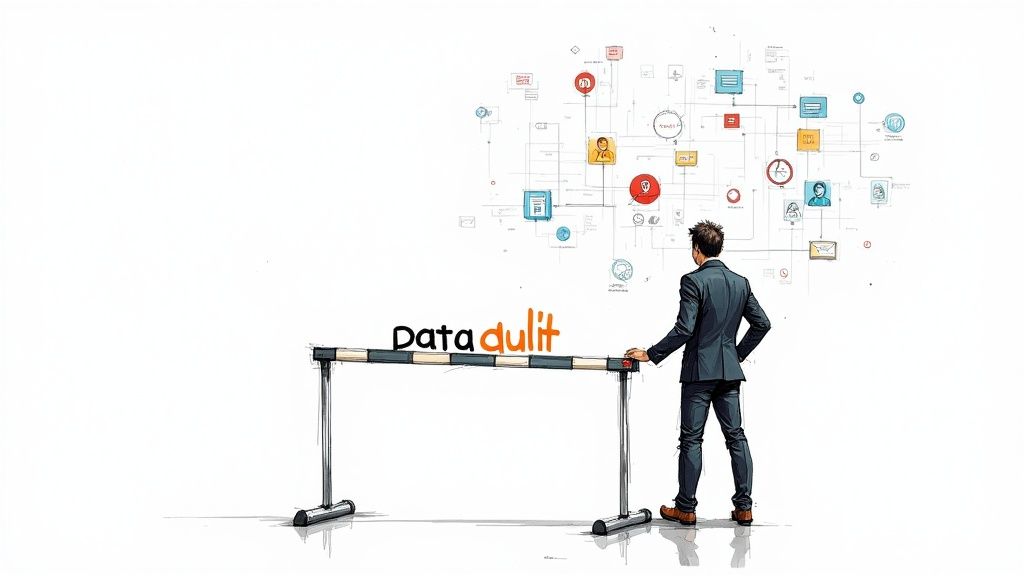
The success of your AI Proof of Concept almost entirely depends on who you choose to build it with. When you're looking for proof of concept AI consulting, think of it less like hiring a vendor and more like finding a true partner. You need someone who not only gets your vision but can actually build a working model that brings it to life.
A great partner brings more than just coding skills to the table. They should come with a well-defined methodology and a genuine curiosity about your specific business problems. They'll guide you through every stage, from the initial AI requirements analysis to the final review, making sure the project never loses sight of your objectives. This kind of hands-on collaboration is the foundation of any good AI strategy consulting engagement.
The AI field is exploding. The market has already hit $196 billion and is expected to grow by a staggering 37.3% each year through 2030. With 80% of executives believing AI is essential for their future, the need for expert guidance is at an all-time high—especially since most companies don't have that deep expertise in-house. The best firms distinguish themselves with a history of success and practical tools, not just their brand name. You can learn more about what sets the top AI consulting firms apart.
Look for Proven Technical Mastery
Your first question for any potential partner should be about their track record. Don't be shy—ask to see a portfolio of their real-world use cases that solved real business problems and delivered measurable value. A firm with battle-tested experience knows where the common pitfalls are and can steer you toward the most effective technical path for your specific challenge.
Their expertise should also align with the AI technologies your project needs, whether that’s natural language processing (NLP), computer vision, or predictive modeling. This is crucial because it shows they’re not just hammering every problem with the same tool but are carefully selecting the right technology for the job.
Prioritize a Structured and Transparent Process
A top-tier consulting partner should operate with total transparency. From your very first conversation, they should be able to clearly walk you through their process. This isn't just a vague promise; it means having a solid AI strategy framework that provides structure and keeps everyone on the same page.
A partner's methodology should feel like a clear roadmap, not a mysterious black box. They should define clear deliverables, timelines, and communication protocols from day one, so you always know where the project stands.
Look for a firm that offers more than just development. The best ones provide strategic resources, like an AI Strategy consulting tool, to help make the entire process smoother and more effective. At the end of the day, you’re choosing a team that will function as an extension of your own. So, pick a partner, like our expert team, whose commitment to your success is obvious.
Turning a Successful PoC into Enterprise Value
A successful Proof of Concept isn’t the finish line—it's the starting pistol. The real work begins now. Your focus has to shift dramatically from the controlled, almost laboratory-like environment of the PoC to the messy, complex reality of a full-scale deployment.
The question is no longer a simple "Can this work?" Now, it's a much bigger challenge: "How do we make this work for everyone, everywhere, and do it reliably?"
From Validation to Full-Scale Implementation
Making that leap requires a completely different mindset. While the PoC was all about speed and getting to a quick validation, scaling is a different game entirely. It’s about building something that’s stable, secure, and ready for the big leagues—something that can handle the unpredictable demands of the real world and deliver consistent value across your entire organization.
This is where you need a rock-solid scaling plan. Think of it as your blueprint for turning that promising prototype into a production-ready powerhouse.
The insights you gathered during the PoC are pure gold here. Did you run into data quality issues? Now’s the time to build permanent data governance solutions. Did the model show some unexpected biases? Your scaling plan must include rigorous, ongoing monitoring to catch and correct those problems before they cause real harm.
This strategic approach is what separates a stalled project from a true enterprise asset. To see how this process is structured in practice, you can explore our AI implementation support services, which are designed specifically for this critical transition.
Your detailed plan should cover a few key areas:
Infrastructure Preparation: Can your current systems actually handle the load? You need to assess whether you're ready for a live AI application or if you'll need to invest in new cloud services or on-premise hardware.
Integration Strategy: You have to map out exactly how this new AI solution will plug into your existing software stack. How will it talk to your CRM, your ERP, and all the other core systems your business runs on?
Organizational Change Management: This is the people part. You need to prepare your teams for new ways of working. This means designing effective training, communicating clearly and often, and setting up support channels to make adoption as smooth as possible.
Managing Change and Ensuring Adoption
Let's be honest: even the most brilliant AI tool is useless if nobody uses it. A huge part of scaling is managing the human element of change. The small-scale test during your PoC gave you a sneak peek into the kind of training and support your teams will need.
You have to build a continuous feedback loop. Give users a way to report issues, ask questions, and suggest improvements. When you make them active participants in the rollout, they become champions for the technology instead of just passive recipients.
A successful rollout is less about flipping a switch and more about carefully nurturing adoption. The goal is to make the AI solution an indispensable part of your team’s daily workflow.
The growing need for this kind of guidance is reflected in the market. The global AI consulting market, currently valued at around $8.75 billion, is expected to skyrocket to nearly $58.19 billion by 2034. This explosive growth underscores just how critical expert guidance is for taking an AI project from a successful PoC to a powerful, company-wide competitive advantage. For a deeper dive into these numbers, check out the full AI consulting market report.
Common Questions About AI Proof of Concept Consulting
Even with a solid plan, it’s natural to have questions when you’re about to dive into an AI proof of concept. Let's tackle some of the most common ones we hear from business leaders. Getting these answers straight helps build the confidence you need to take that first step.
What Is the Difference Between an AI PoC and a Prototype?
Think of it this way: a Proof of Concept (PoC) is a science experiment, while a prototype is a scale model.
A PoC is designed to answer one simple, crucial question: "Is this idea even technically possible, and could it actually deliver value to the business?" It's a small, focused test to see if a core idea holds water.
A prototype, on the other hand, is all about showing what a future product might look and feel like. A PoC tests if an idea works; a prototype shows how it might work. In the world of AI, the PoC always comes first. It’s the smart way to reduce risk before you commit to building something more elaborate.
How Long Does a Typical AI PoC Project Take?
The exact timeline will always depend on the complexity of your idea and how good your data is, but a well-scoped PoC is designed for speed. The entire point is to get you clear, actionable insights—fast.
On average, a proof of concept in AI consulting usually takes somewhere between four and 12 weeks. The goal is to avoid getting stuck in a long, drawn-out development cycle. Instead, you make a quick, informed decision on whether it makes sense to scale the project.
What Happens If an AI Proof of Concept Fails?
Honestly, a "failed" PoC is one of the best possible outcomes. It’s actually a huge win.
Why? Because it proves, with minimal time and money spent, that a specific idea isn't the right path for your business right now. That kind of clarity is incredibly valuable. It stops you from pouring a significant budget and months of your team's time into a strategy that was doomed from the start.
A PoC that doesn't meet its goals isn't a failure—it's a smart, data-driven off-ramp that saves you from a much larger mistake. It allows you to fail small and learn fast, so you can pivot your resources to an AI initiative that will succeed.
This is the real power of the PoC. As we explored in our AI adoption guide, this early validation is what separates successful AI projects from expensive ones that go nowhere.
What Kind of Team Is Needed for an AI PoC?
You don't need a huge army to pull off a great PoC. In fact, they work best with a small, focused, and collaborative group. Your core team should include:
A business sponsor: The champion who owns the project's vision and goals.
Subject matter experts: The people who know the business problem you're solving inside and out.
A technical team: The hands-on crew to manage the data and build the model.
This is where a good consulting partner comes in. They provide the specialized AI talent—like data scientists and machine learning engineers—who can guide the strategy and handle the technical heavy lifting, making the whole process much more efficient. The people behind the project are just as crucial as the technology itself. To see who powers our insights, you can meet our expert team.
Ready to turn your AI idea into a validated business case? At Ekipa, we specialize in helping companies quickly test and prove their AI concepts. Our next-gen AI strategy consulting platform is designed to help you uncover and execute AI opportunities without the high cost of traditional consultants. Our expert team is here to guide you every step of the way.

